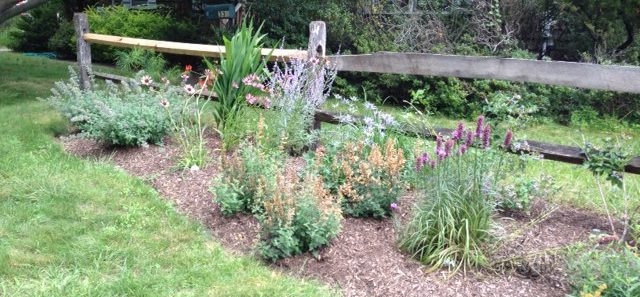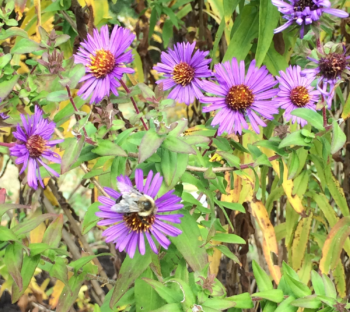Protecting & Restoring Long Island's Peconic Bays
Help reduce pollution in our bays by installing rain barrels, reducing fertilizer use, and planting natives in your yard.

Planting a native plant or rain garden or installing rain barrels can mitigate stormwater runoff into our bays. Reducing your fertilizer use can also reduce the amount of nitrogen entering our bays and groundwater.
Stormwater filtered through the soil, sand and gravel within rain or native plant gardens is dramatically cleaner when it enters our groundwater, nearby bodies of water and storm drains. Rain barrels offer an opportunity to catch rainwater from roof runoff for reuse in gardens rather than letting the water flow over paved surfaces and into storm drains, nearby bodies of water and groundwater.
If you live within the Peconic Watershed, homeowners can earn up to $500 to offset the expense of installing green infrastructure on their properties including rain barrels, rain gardens, and native plant gardens. Learn more on the Homeowner Rewards Program Page.
If you do not live within the Peconic Watershed, we hope you will still install rain barrels and a native plant or rain garden on your property.
The Interactive Yard Tool can help you visualize your Peconic-friendly yard and launch your planning process!
We hosted a Native Plant Virtual Workshop with the Long Island Native Plant Initiative and Group for the East End. Check out the workshop recording to learn the ins and outs of native plant gardening.
Feel inspired after watching the workshop? Here is a great list of resources to help you get started: Long Island Native Plant Initiative (LINPI) Native Plant Resources
PEP partnered with the Long Island Regional Planning Council (LIRPC) to develop a “Reduce Nitrogen Pledge” for the Long Island Nitrogen Action Plan. Check out 10 ways you can reduce your personal nitrogen inputs and take the pledge to be recognized as a leader in helping to combat nitrogen pollution in our community!
Follow the Long Island Nitrogen Action Plan (LINAP) nitrogen fertilizer recommendations on your property. See more information below.
Stormwater is rain or melting snow that flows over roads, parking lots, driveways and lawns entering a storm drain system or discharged directly into nearby waterbodies. Stormwater carries pollutants like motor oil, sediment, pet waste, garbage, fertilizers and pesticides that can be harmful to aquatic life and create human health risks. Harmful algal blooms, restricted shellfish harvest, and marine life die-offs have been linked to an excess of nutrients and other harmful chemicals in the Peconic Bay. Rain gardens and rain barrels reduce the amount of nutrients and chemicals that enter bodies of water.
The Long Island Nitrogen Action Plan (LINAP) has developed nitrogen fertilizer recommendations to balance the need to significantly reduce nitrogen loads to Long Island’s waterbodies and to have a green, lush lawn. After working with the LINAP Fertilizer Management Workgroup, recommendations were developed that will allow fertilizer users to do their part to help improve water quality issues plaguing their waters. These recommendations are all backed by scientific studies and experts in the field.
The recommendations were written to cover the full spectrum of fertilizer matters that apply to homeowners, landscapers, golf courses, and industry. Below are the recommendations for homeowners to follow:

Native plants are naturally found in a particular geographic region and have been growing in that area for thousands of years. They are naturally adapted to the type of climate, soil, rainfall and availability of pollinators, like bees and butterflies and require low maintenance and do not require fertilizers. Additionally, native plants can survive native pest attacks better than most non-natives. Invasive, non-native plants are not naturally found in the region. Once they arrive, they threaten native plant species because they grow quickly and aggressively.
Search the Peconic-Friendly Plant Database
By using native plants you are promoting a healthy natural ecosystem and providing essential habitat to local butterflies, birds and bees.
Interactive Yard Tool – Use this tool to plan your Peconic-friendly yard!
Peconic-Friendly Plant Database – This plant database helps you browse Long Island Native plants to select for your yard based on type, light, soil, and moisture requirements.
Healthy Soils – Maintaining healthy soils will keep your yard productive and reduce pollution to local waterways.
PEP’s Demonstration Rain Garden – Learn about the PEP’s rain garden on Heidi Behr Way in Riverhead.
PEP’s Homeowner Rewards Program – Details and instructions on how to apply for the Peconic watershed rebate program for native plantings, rain gardens, and rain barrels.
Environmentally-friendly fertilizer use and pest management-Alternative techniques can save you money, effort, and eliminate potential risks to the environment, including impacts on groundwater.
USEPA National Stormwater Calculator– A free software application to estimate annual rainfall and frequency of runoff to help determine the appropriate size of your rain garden.
Sign up for News, Events and Information straight to your inbox.
